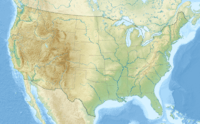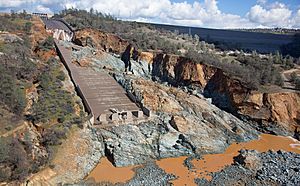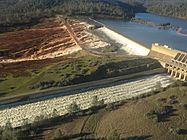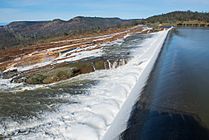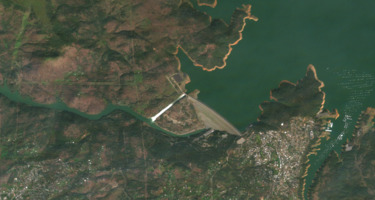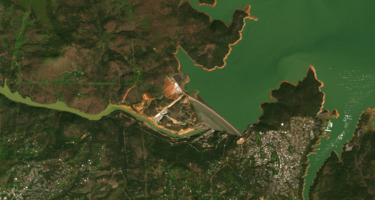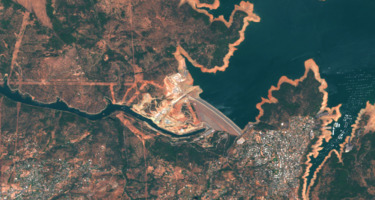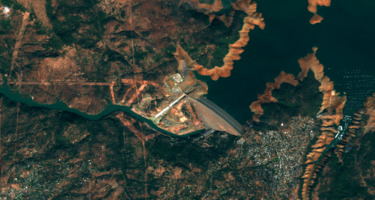Oroville Dam facts for kids
Quick facts for kids Oroville Dam |
|
|---|---|
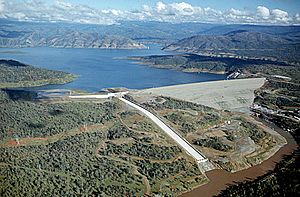 |
|
|
Oroville Dam
|
|
| Country | United States |
| Location | Oroville, California |
| Coordinates | 39°32′20″N 121°29′08″W / 39.53889°N 121.48556°W |
| Purpose | Water supply, flood control, power |
| Status | Operational |
| Construction began | 1961 |
| Opening date | May 4, 1968 |
| Owner(s) | California Department of Water Resources |
| Dam and spillways | |
| Type of dam | Zoned Earthfill |
| Impounds | Feather River |
| Height (foundation) | 770 ft (235 m) |
| Length | 6,920 ft (2,109 m) |
| Dam volume | 77,619,000 cu yd (59,344,000 m3) |
| Spillway type | Service, 8x gate-controlled |
| Spillway capacity | 150,000 cu ft/s (4,200 m3/s) (service) |
| Reservoir | |
| Creates | Lake Oroville |
| Total capacity | 3,537,577 acre⋅ft (4.363537 km3) |
| Inactive capacity | 29,600 acre⋅ft (0.0365 km3) |
| Catchment area | 3,607 sq mi (9,340 km2) |
| Surface area | 15,805 acres (6,396 ha) |
| Normal elevation | 901 ft (275 m) (spillway crest) |
| Power station | |
| Hydraulic head | 615 ft (187 m) |
| Turbines | 3x conventional 3x pump-generators |
| Installed capacity | 819 MW |
| Capacity factor | 21% |
| Annual generation | 1,629 GWh (2001–2012) |
The Oroville Dam is a huge earth-filled dam on the Feather River in California. It's located east of the city of Oroville, California, in the Sierra Nevada foothills. At 770 feet (235 meters) tall, it's the highest dam in the United States!
This dam is super important for California. It helps supply water, creates electricity, and controls floods. The dam holds back water to form Lake Oroville, which is the second largest human-made lake in California. This lake can store a lot of water – more than 3.5 million acre-feet.
The California Department of Water Resources (DWR) built the Oroville Dam. It's a key part of the California State Water Project (SWP). This project helps manage California's water system. Construction started in 1961. Even with challenges like floods and a train crash, the dam was finished in 1967 and ready to use in 1968. Soon after, the Edward Hyatt Pump-Generating Plant started making electricity. It was the biggest underground power station in the country at that time.
Since 1968, the Oroville Dam has controlled the flow of the Feather River. Water from the dam goes into the State Water Project's California Aqueduct. This aqueduct provides water for farms in the San Joaquin Valley. It also supplies drinking water to cities in Southern California. The dam has saved the area from over $1.3 billion in flood damage between 1987 and 1999.
However, the dam also affects fish. It blocks fish from swimming up the Feather River. To help, a salmon and steelhead fish hatchery was built. This hatchery started working soon after the dam was finished.
In February 2017, there was a big problem. The dam's main and emergency spillways were damaged. This led to 188,000 people living nearby having to leave their homes. Once the main spillway was stable and the lake level dropped, people could return home.
Contents
History of the Oroville Dam
Why the Dam Was Built
In 1935, work began on the Central Valley Project (CVP). This project aimed to use the Sacramento and San Joaquin rivers to water farms in the Central Valley. After World War II, California grew very fast. It became clear that the state needed more water than just for farms.
In 1951, an engineer named A.D. Edmonston suggested the Feather River Project. This project was the start of the State Water Project (SWP). It included building a large dam on the Feather River at Oroville. It also planned for canals and pumps to move water to central and southern California. Some people in northern California and parts of southern California did not like this idea. They already got water from the Colorado River. But farmers and other southern Californians supported it.
Major floods in the 1950s helped get a flood-control law passed in 1957. This law provided money to build a dam at Oroville. This happened even before it was officially part of the SWP.
Building the Dam
Work on the dam started in May 1957. First, the Western Pacific Railroad tracks in the Feather River canyon had to be moved. The law that approved the SWP, called the Burns-Porter Act, passed in November 1960. It passed by a very small number of votes. Donald Thayer, an engineer from the DWR, was in charge of designing and building the dam.
Workers dug two long tunnels to move the Feather River around the dam site. Each tunnel was 4,400 feet (1,341 meters) long and 35 feet (11 meters) wide. One tunnel was for normal river flow. The other was only for floods. In May 1963, workers finished pouring concrete for a 128-foot (39-meter) tall temporary dam. This temporary dam protected the construction site from floods. It later became a strong part of the finished dam.
Next, an 11-mile (18-kilometer) railway was built. This railway moved earth and rocks to the dam site. About 120 train cars ran every hour. They carried material mostly from huge piles of mining waste left by the California Gold Rush.
On December 22, 1964, a big flood almost caused a disaster. The Feather River had heavy rain for days. The water behind the dam, which was not yet finished, rose very high. The incomplete dam helped reduce the flood's power by almost 40 percent. This saved the area from a lot of damage.
Later, in October 1965, four men died in a train accident. Two work trains crashed, causing a fire that burned 100 acres (40 hectares) of forest. This crash delayed the dam's construction for a week. In total, 34 men died while building the dam.
The Oroville Dam was built to survive strong earthquakes. It has hundreds of tools inside that measure water pressure and how the earth settles. Because of these tools, it's called "the dam that talks back." The dam was finally finished on October 6, 1967. It took over 40,000 train trips to move 155 million tons of material. On May 4, 1968, the Oroville Dam was officially opened. Important people like California Governor Ronald Reagan were there. Nearly 50,000 people attended a week of celebrations in Oroville.
Spillway Concerns Before 2017
In 2005, some environmental groups asked federal officials to make the dam's emergency spillway stronger. They wanted it covered with concrete instead of just earth. They worried that in a very big flood, the main spillway might be overwhelmed. Then, water would flow over the emergency spillway. This could cause a lot of erosion and lead to flooding downstream. Officials at the time said this was not needed.
In 2013, cracks were found in the spillway. Engineers said it was normal for spillways to have some issues. They made repairs, and everything seemed fine. In 2015, the dam spillway was checked visually, but not up close.
2017 Spillway Failure
Initial Damage to the Spillway
The winter of 2016–2017 was the wettest in Northern California in over 100 years. Heavy rains caused a lot of water to flow into Lake Oroville. The dam's main spillway was opened in January to release water. In February, after more heavy storms, the spillway flow was increased. On February 7, DWR workers saw something unusual. They stopped the water flow and engineers checked the spillway.
The engineers found a large area where the concrete and ground underneath had been washed away. This damage was too big to fix quickly. The lake's water level kept rising, so dam operators had to keep using the damaged spillway. This caused even more damage. Debris from the hole in the spillway flowed downstream. It damaged the Feather River Fish Hatchery because the water became very muddy.
Engineers hoped to drain the lake using the damaged spillway to avoid using the emergency spillway. But they had to slow down the water release. This was because of possible damage to nearby power lines.
Using the Emergency Spillway and Evacuation
On February 11, 2017, the emergency spillway was used for the first time since the dam was built in 1968. Water flowed directly onto the earthen hillside, as it was designed to do. However, the water started to erode the hillside. This threatened to wash away the concrete wall of the emergency spillway.
On February 12, an order was given for people in low-lying areas to leave their homes. This was because the emergency spillway might fail. The flow over the main spillway was increased to try and slow down the erosion of the emergency spillway.
By the evening of February 12, the increased water flow had lowered the lake level. The emergency spillway stopped overflowing. On February 14, the evacuation order was lifted.
Investigation and Repair Work
On May 19, the spillway was closed for the summer so repairs could begin. The repairs were expected to cost over $400 million. The company Kiewit Construction was given the main contract. The Federal Emergency Management Agency (FEMA) was expected to pay for a large part of the costs.
Experts are still trying to find the exact reason for the spillway failure. They have found 24 possible causes. These include problems with the drainage system, how thick the concrete was, and rust in the steel bars inside the concrete.
The government planned to rebuild the undamaged part of the spillway in 2018. This part was also found to have problems. Workers also extended a wall under the emergency spillway. This wall will help prevent erosion if the emergency spillway is used again.
By November 1, 2017, the main spillway was ready for winter water flows. This finished the first part of the repairs. The second part, completed in 2018, included rebuilding the top section of the spillway. It also involved adding concrete slabs and a new wall for the emergency spillway. The total cost was estimated to be over $500 million. In October 2017, small cracks were found in the newly rebuilt spillway.
| How the Spillway Looked Over Time (Satellite Images) |
|---|
After the repairs, the DWR kept Lake Oroville at a lower level than usual. This was to reduce the chance of needing the spillway the next winter. In 2018–19, the temporary repairs on the main spillway were replaced with strong, steel-reinforced concrete.
On April 2, 2019, the DWR started releasing water over the newly rebuilt spillway. This was due to heavy rainfall. They increased the flow on April 7 to test how the spillway worked at higher levels.
How the Dam Works
Making Electricity
The Edward Hyatt Pump-Generating Plant is located underground. It was finished shortly after the dam. At the time, it was the largest underground power station in the U.S. It has three regular turbines and three pump-generators. In total, it can produce 819 megawatts (MW) of power.
The Hyatt Powerplant can pump water back into Lake Oroville when there is extra electricity. The pump-generators can lift a lot of water into the lake. When all six turbines are running, they use a large flow of water to make electricity.
Since 1969, the Hyatt plant has worked with other facilities called the Oroville–Thermalito Complex. These facilities are west of Oroville. Water is sent to the upper Thermalito reservoir. When electricity use is low, extra power from Hyatt is used to pump water from a lower reservoir to the upper one. This water is then released back to make up to 114 MW of power when electricity demand is high. The Hyatt and Thermalito plants make about 2.2 billion kilowatt hours (kWh) of electricity each year. This is about half of all the power made by the State Water Project's power plants.
Water Supply
Water released from Oroville Dam flows down the Feather River. It then joins the Sacramento River. Eventually, it reaches the Sacramento–San Joaquin River Delta. From there, the SWP's California Aqueduct takes the fresh water. This water is sent to the dry San Joaquin Valley and Southern California.
The power plants at Oroville–Thermalito provide about one-third of the electricity needed to pump water through the aqueduct. This water is pumped from the delta into the valley. Then, it's pumped over the Tehachapi Mountains to coastal Southern California. Water and power from the dam help water farms and supply drinking water to about 25 million people. At least 2.8 million acre-feet of water are released each year.
Controlling Floods
During winter and early spring, Lake Oroville must have space for flood control. About one-fifth of the reservoir's storage capacity is kept empty for this purpose. The dam is operated to release water at a controlled rate during floods. In the big flood of 1997, a lot of water flowed into the reservoir. But dam operators managed to limit the outflow. This saved large parts of the Sacramento Valley from flooding.
Feather River Fish Hatchery
The Oroville Dam completely blocks the path of Chinook salmon and steelhead trout in the Feather River. These fish usually swim upstream to lay their eggs. In 1967, the DWR and the California Department of Fish and Game built the Feather River Fish Hatchery. This was to make up for the lost natural fish habitat.
A special dam, built in 1962, stops salmon and trout before they reach the main dam. It guides them up a fish ladder to the hatchery. The hatchery is on the north bank of the Feather River. Each year, the hatchery produces 10 million young salmon and 450,000 young trout. These young fish are then released into the river. This hatchery has been so successful that there is a concern. The hatchery-raised salmon might be competing with the remaining wild salmon in the Feather River.
Images for kids
See also
 In Spanish: Presa de Oroville para niños
In Spanish: Presa de Oroville para niños



